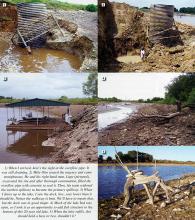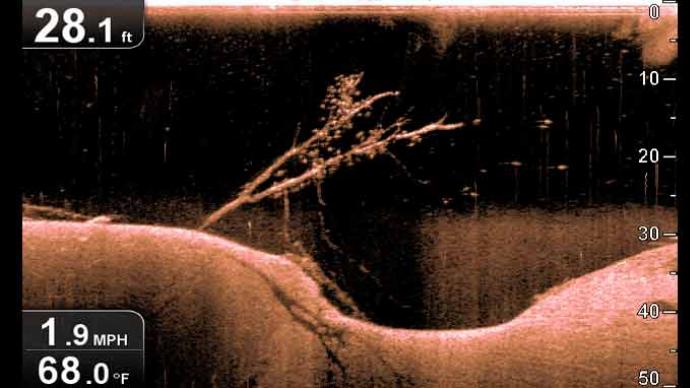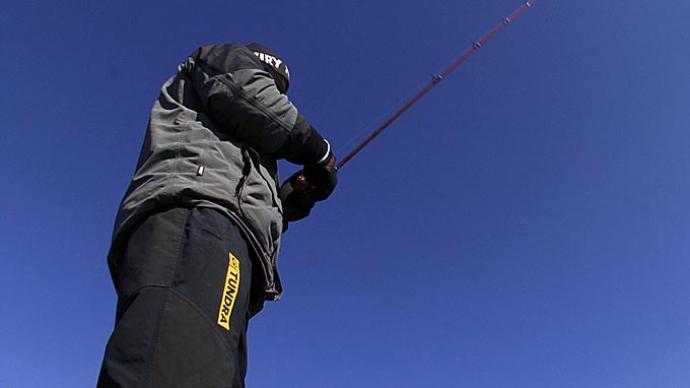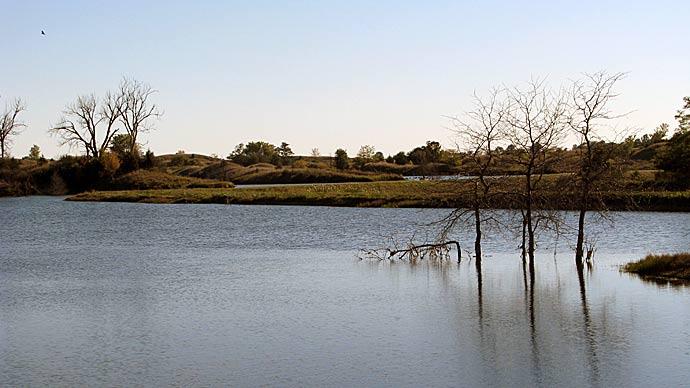As a youngster learning to fish, I dreaded hanging-up in brush. Most of my outings were in small ponds near my home town of Paris, Texas. Much of the time I was wading. Walking to the lure meant disturbing my fishing area. It also cost valuable angling time. That was frustrating to a 12-year-old who had waited all week for this moment.
My Dad patiently said, "Don't worry. If you don't snag a bush or limb occasionally, you're not throwing where the fish live." He was an accomplished hunter and fisherman. That advice helped me develop accurate casting skills and catch more fish.
If I had retained as much from schoolteachers as I did my Dad's outdoor classroom, I probably could have been a rocket scientist.
In 1990,1 was managing an outdoor hunting and fishing club in West Texas. The members enjoyed more than 5,000 acres of great hunting country, but only two small fishing ponds. They wanted to build a lake with a goal of catching eight to 10-pound bass. I asked a physician friend whom I should contact to design the project. He unequivocally answered, "Call Bob Lusk."
I went to Bob's home in Whitesboro. When the visit ended, I had a new term in my vocabulary—pond management. Bob placed a big emphasis on what I now call the first commandment of successful management— HABITAT. He described the importance of cover, like "brush piles". I smiled while recalling where I first heard that statement. Bob explained why the bass I caught in those northeast Texas pools were cruising brush piles. I flashed back to many boyhood experiences. I stayed so long; Bob invited me to join his family for dinner.
We had meatloaf.
After that day, I feel Bob adopted me. During the following 20-years, I've been blessed to follow my passion from time to time on the bow of his electrofishing boat. My wife refers to it as my obsession. Many of you will relate to that loving reference. I've learned from Bob's shoreline consultations while he held a handful of dripping vegetation. I've shared the wide-eyed excitement of a new pond owner who just heard he could raise one to two-pound coppernose bluegill for his kids or grandchildren. I developed a new art form— brush pile sculpture.
Bob stresses that fish must have proper habitat to thrive. Whether touring a new construction site or 15-year-old lake, habitat is the first part of the environment he evaluates. As goes habitat, so goes what lives in it. Habitat consists of water, its chemistry, biology, and yes, cover, like brush piles. These fortresses provide safe havens for newly spawned fish to avoid predation and grow-up to contribute future generations of forage. They contribute places where fish congregate, feed, and loaf, he says.
The club lake became a 25-acre success. Bragging rights belong to an 11.1 pound largemouth weighed post spawn. We've burned a lot of midnight oil guesstimating where that ol' gal would have tipped the scales when settling on her spawning bed. (Some sources say you can assume 15-20 percent more.)
Since I was there when lake contractors broke ground, it's like my third child. During construction, I helped Bob rotenone rough fish from standing water in the lakebed. I strolled a massive core trench of the dam. With my six- foot, five-inch height, I walked upright through the eight-foot diameter flood control riser just before it was erected. Little did I know that riser would contribute a prominent chapter in the lake's history.
When the lake was completed nearly twenty years ago, a storm of the century blew through with torrential rains and big winds. The watershed swelled with water and the lake filled in only 14-hours and ran around the emergency spillway. It was easy to see why engineers recommended an eight-foot pipe for that watershed and plenty of freeboard above the pipe.
During April, a 5.5-inch rain sent the lake on a record rise, approximately six-feet "over" the surface of the overflow pipe. Three weeks later, another three-inches fell. I watched the lake weather similar events. I have photos of water thundering out behind the dam. They resemble pictures of the geyser. Old Faithful, at Yellowstone National Park.
I had anxiously watched weather radar from my home in Fort Worth, Texas. There was lots of red in that radar loop...twice. I couldn't get the lake off my mind. I had one of those feelings when you sense you should call an old friend. After that one-two punch from the watershed, I decided to go check her mood.
I drove the 100 miles northwest from home base.
With the gate unlocked, I drove down the rock road and veered toward the lake.
Trees blocked my approach to the lake. As I glanced across the lake at the floating dock, the roof was at ground level and sitting at a funny angle. It sits perched and anchored against a sheer shoreline over a 25-foot borrow pit. I assumed some pontoons had sprung a leak and the dock partially sunk. Then my eyes moved left.
That's about when my heart sunk and a lump in my throat took my breath.
A country boy doesn't experience many "surreal" moments. This was my first. What I saw reminded me of a movie scene. I stared in disbelief. When I remembered to take a breath, I realized the lake was gone! Only a few acres of water remained. I'm close to Nature. I'm close to Her critters. I sat in disbelief on a big rock and paid my respects to a grand ol' lady who brought so much joy to those who knew her. Occasionally, a fish struck the surface. I like to think it was an amen, to my tribute.
I called earth mover extraordinaire Mike Otto.
He must have heard the urgency in my voice and came over right away.
He climbed down a gaping hole around the riser and spotted the culprit. A 20-year-old welded seam had blown-out near a 60-inch horizontal pipe through the dam. Torrents of pressure from the hole chiseled away soil around the riser and collapsed the face of the dam. Twelve feet of water flowed out along the pipe through the dam.
We talked the situation over, brainstormed and came up with a workable plan.
Mike removed the riser, sealed the horizontal pipe with concrete and rebuilt the dam. He enlarged our spillway to carry future floodwaters previously discharged by the riser system.
Even though it was like losing an old friend, we had an opportunity to build her back stronger than ever and give this grand lady a new life. As I walked the lakebed, there seemed only one contribution from me. You guessed it—brush piles. The shoreline is strewn with rocks that limit rooted vegetation growth. Rocks provide cover for small fish, but not large ones. There's very little standing timber. Most of it's in deep water. Shoreline habitat needed enhancement. I gathered trees with fine, tight limb structure for baitfish. I stacked bigger, open logs for bass. When the lake returns to normal pool, my sunken treasure will be at five to seven feet.
Strategically placed brush piles or artificial attractors provide staging areas for fish to transition through season changes when water temperature rises and falls. Sink them on points, creek channel ledges, and drop-offs. For our situation, we decided four per acre is sufficient. Carefully calculate depth placement. Ensure they will be covered and productive during summer months when lake levels may drop two or three feet. Typical attractants are six- feet by six-feet by six-feet. Anchor them with a concrete hadite block or other creative weight.
I mark locations with 10-foot electrical PVC pipe. Saw a two-foot section off the jointed end. It will be the base. Make a diagonal cut on the bottom of the base to create a spike. Drive it into the ground. Attach the base to your pile with plastic wire tires. Ties will last a long time and add support to keep the pipe straight. Insert the remaining eight-foot length and trim to your preferred height above the surface. This method eliminates string on a floating buoy that can tangle lures.
There's nothing more exciting than seeing a bass blow-up on a buzz bait as it churns between stickups. Or setting the hook on a heart-stopping strike as your top water crosses a pile of timber. Remember the last swirling hit as your spinner bait rolled over a log? Few moments in angling rival the tug of war with a bass hunkered down in her domain.
Fishing for lunker bass is like hunting trophy deer, a game of wits. You set up on a food plot anticipating the buck will come to feed or look for does. Bass are predators. Construct a brush pile. They'll occupy it to ambush food or visit regularly searching for food. Are you thinking about honey holes on your lake that consistently produce fish? I'll wager there's an interesting collection of lures snagged on whatever cover is there.
Brush pile sculpture won't be displayed at the Smithsonian Institute. But I bet it will have a place of honor in a habitat exhibit at the Pond Management Hall of Fame.
Some guys enjoy building things inside a workshop. I like putting on hip boots and creating a brush pile. I encourage you to assess habitat, especially cover. It will increase food chain survival. It will improve angling success. It will stir fond recollections of a big bass you wrestled from heavy cover. More important, it will bring back golden memories of your favorite fishing partner who first taught you the benefits of fishing brush piles.
Reprinted with permission from Pond Boss Magazine





